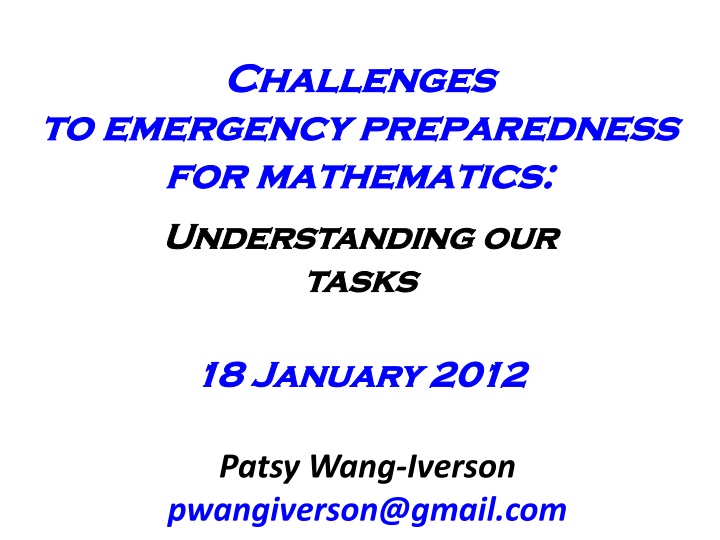
Fostering Mathematical Thinking in Disaster Preparedness Education
Explore the importance of mathematical thinking in preparing children for emergencies through lessons on self-help during disasters, problem posing by students, and teacher professional development. Discover strategies for integrating disaster risk reduction into education and empowering students to act autonomously.
Download Presentation

Please find below an Image/Link to download the presentation.
The content on the website is provided AS IS for your information and personal use only. It may not be sold, licensed, or shared on other websites without obtaining consent from the author. If you encounter any issues during the download, it is possible that the publisher has removed the file from their server.
You are allowed to download the files provided on this website for personal or commercial use, subject to the condition that they are used lawfully. All files are the property of their respective owners.
The content on the website is provided AS IS for your information and personal use only. It may not be sold, licensed, or shared on other websites without obtaining consent from the author.
E N D
Presentation Transcript
Challenges Challenges to emergency preparedness to emergency preparedness for mathematics: for mathematics: Understanding our Understanding our tasks tasks 18 January 2012 18 January 2012 Patsy Wang-Iverson pwangiverson@gmail.com
This project can help us prepare our children for the future. It illustrates the importance/value of mathematical thinking.
Day 1: 14 February 2012 Katsumi SHIRAHATA: Self-help and public help When disaster occurs, children must make independent decision Moving from saving children in disaster to children saving themselves and others in disaster.
What kinds of lessons? Business as usual? 1. Skills development 2. Doing as teacher directs or Problem posing by students? Example: 16 Feb. Isoda lesson BUT No proposed lessons have followed this example.
Problem Posing by Students ISMUNANDAR: Teacher Professional Development for Mainstreaming Disaster Risk Reduction in Education in ASEAN BUT Teachers can t learn/know everything in the 21st century. BENJALUG NAMFA: 1) Integrated curriculum; 2) Changing teaching practice MAITREE INPRASITHA: Lesson study and open approach
Problem Posing by Students SHIZUMI SHIMIZU: Eventually, it is necessary that opportunities are given so that students can act independently and autonomously. AND Pose and solve their own problems.
14 Feb. Panel Discussion Education about disaster prevention is not something you can do overnight; it is a long-term effort. BUT We need to develop disaster reading materials and lesson plans, engage in lesson study, and report back by 7 September!
Possible Learning Content A Knowledge of why and how Earthquake and Tsunmai happen B Models related to Earthquake and Tsunmai (mathematics and physical model) C Prevention and damage control (Good Building and Logistic arrangement) D After the disaster (Relief Work and its arrangement)
Problem Posing using Prior Knowledge ? ? Earthquake? ? ? ? 1-2? ? ? ? ? ? ? 3-4? ? ? ? ? ? ? ? 5-6? ? ? ? ? ? ? ? ? ? 7-8? Modeling? /solving? ? problem? ? ? ? ? ? ? ? ? ? ? Area? Ratio? ? ? ? ? ? ? ? ? ? ? ? ? ? ? ? ? ? ? ? ? ? ? ? decimals? ? ? ? ? ? ? ? ? ? ? ? ? ? ? ? ? ? ? ? ? ? ? ? ? tables? ? ? ? ? ? ? ? ? ? ? ? ? ? ? ? ? ? ? ? ? ? ? ? ? graphics? ? ? ? ? ? ? ? ? ? ? ? Big? number? ? ? ? ? ? ? ? ? ? ? ? ? ? ? ? ? ? ? ? ? ? ? ? ? ? ? ? ? ? ? Volumen? ? ? ? ? ? ? ? ? ? ? ? ? ? ? ? ? ? ? ? ? ? ? ? ? ? ? ? ? ? ? ? Similarity? ? ? Yes? ? ? ? ? ? ? ? ? ? ? ? ? Yes? ? ? ? Not? ? ? ? ? ? ? ? ? ? ? ? Yes? ? ? ? Etc.? Tsunami? ? ? ?
BEFORE IMMEDIATE MID-TERM LONG-TERM PRIOR EMERGENCY MANAGEMENT RECONCEPTUALIZATION KNOWLEDGE RETURN TO NORMALCY DAMAGE REDUCTION Relocation Rescue Prediction Removal Protection Reallocation Prevention? Relief Restoration Rehabilitation R Preparedness P Reconstruction Q Research Education/ Training Drill KM Research Research Education Education S Research Education Drill KM
Scientist Presentations Makoto Matsubara: Strong velocity gradient related to the 2011 Tohoku Earthquake using travel time data from active seismicity detected by the dense seismic network. Gaku Shoji: Damage of infrastructures due to the 2011 Earthquake off the Pacific Coast of Tohoku Masanori Shishikura: Importance of studying past tsunami by geological field survey
Scientist Presentations Bring real science to education Help students and teachers understand what scientists do Serve as models for students future aspirations
Full STEAM* Ahead! Science Technology Engineering Art Mathematics
APEC Lesson Study Developing students who are agents of change, not objects of change.
E-Textbook Mild improvement of boring textbook? Inclusion of animation, movie?
ORIGAMI Using origami to build portable temporary shelters 6th International Meeting on Origami in Science, Mathematics and Education (6OSME) March, 2014 Kobe, Japan
